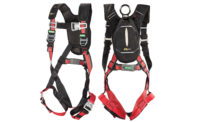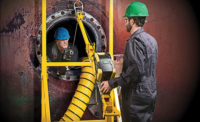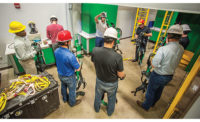New year, new rule. As we ring out the old in 2016, we ring in the first major general industry OSHA update since the 1970s for walking-working surfaces (subpart D) and fall protection systems standards (subpart I) when a new ruling takes effect on January 17.1
Best practices in walking-working surface and fall protection have evolved over the past several decades along with continually revised national consensus standards that reflect these practices and emerging technology, but OSHA’s standards remained unchanged.2 In November 2016, though, OSHA announced a final ruling that would update and align these standards to provide greater flexibility and ultimately better protect and train general industry workers.3
Why is this update important?
Analyses OSHA performed determined that fall risk is significant and that the new ruling, which impacts about seven million worksites and 112 million employees,2 will prevent 29 fatalities and more than 5,842 lost-workday injuries annually. (For context, OSHA reports that an average of 345 deaths from falls and 202,066 injuries leading to lost workdays occurred each year from 2006 to 2012.3)
Along with lives saved and injuries prevented, OSHA predicts that reducing deaths from falls is valued at $252.3 million each year. The proposed lowered rate of injury could save a yearly $362.2 million, and compliance with OSHA’s revisions to subparts D and I is worth a combined projected $615 million annually. After factoring in an estimated $305.0 million cost of compliance, the net benefit will still be $310 million.2
What does the new ruling mean for you?
You — and your equipment manufacturer — probably already comply with much of the ruling. And while most of it takes affect this January, more complex changes come with longer grace periods of up to 20 years,2 allowing equipment upgrades when needed according to “the normal ‘business cycle’ or ‘useful life.’”4
So, chances are, not a lot is going to change in the selection and purchase of fall protection products. OSHA’s rule might not have been updated (until now), but the general industry community has long since adopted the personal fall arrest system as a means of protection according to OSHA’s “Letters of Interpretation,” which paved the way for such systems. The ruling now better reflects existing standard practice.
What’s different?
More choice: The most significant difference lies in the flexibility this ruling offers employers choosing fall protection systems. Although the “Letters of Interpretation” allowed for personal fall arrest to be used, guardrails were the only type of fall protection permitted under the old rule. Modeled after OSHA’s 1994 performance-based construction rule, the new ruling says you can choose from “any equipment, device, or system that prevents a worker from falling from an elevation or mitigates the effect of such a fall.”3 Permitted forms of fall protection now include
- Guardrails
- Safety nets
- Fall restraint
- Positioning
- Personal fall arrest
- So-called “designated areas”
Simplification
Consistency across construction and general industry makes it much easier for employers—especially those who work in both fields—to comply with the law3 while exposing them to possible solutions they might not have known existed.
OSHA also replaced specification language with performance-based language to make requirements for compliance easier to comprehend.2
Higher standards
When choosing OSHA-compliant equipment, be aware that a considerable change in weight-bearing capacity is now in effect pertaining to the gate strength of snaphooks on fall arrest lanyards and self-retracting lifelines. Under the new rule, hooks with gates must withstand a force of 3,600 pounds in all directions to comply with ANSI Z359.1-2007;2 OSHA previously considered gates that held just 220 pounds from the front acceptable. Many companies will need to replace old gear not equipped with snaphooks with strong enough gates.
Training employees
Another component of this new ruling requires employers to train anyone who uses personal fall arrest about the hazards of fall protection systems and other equipment as well as the danger of falls themselves. Employers are also responsible for retraining workers who have a safety incident, who appear to be missing necessary knowledge or skill, or after any change in products or operations.3
Just as the new standards use performance-based language, training materials must contain straightforward vocabulary and be presented in each worker’s preferred language.2,3 Similarly, if a worker can’t read, training materials have to be in a format accessible to them, and workers using web-based training need to be computer savvy enough to successfully complete the course.2
Training the trainer
Effective fall prevention and protection training starts with an ANSI Z359.2-2007 “Competent Person” making equipment purchase decisions and then training the workforce on best practices for using this equipment and complying with regulations. OSHA says this qualified person “must train these workers to correctly: identify and minimize fall hazards; use personal fall protection systems and rope descent systems; and maintain, inspect, and store equipment or systems used for fall protection.”3
In addition to the new OSHA ruling, within the past decade and even more recently, the development of highly specialized equipment for different applications has increased dramatically. Thus, “Competent People” need extensive training themselves—usually in the form of a 16-hour minimum class—to ensure they understand the different types of equipment on the market for special applications so they can best select equipment designed for the job. Also, and probably more important, they need to be trained on myriad hazards that can result if different pieces of equipment are used incorrectly when it comes to properly calculating fall clearance and minimizing fall forces.
Finding effective training
Reputable companies that produce safety products offer a variety of training resources on proper selection and use of equipment. Choose a flexible provider that delivers the following forms of training:
- Free customized online training programs in dynamic, interesting formats.
- Safety evaluations of your worksites.
- Expert training that comes to you.
- State-of-the art training centers at facilities throughout the country.
OSHA provides its own training programs and other resources to help smaller to mid-sized employers keep employees safe, and offers complimentary expert assistance from consultants.
By following OSHA’s new guidelines for simplified regulations and training, employers and workers can look forward to a safer 2017 with more freedom to choose the equipment that works best for them.
For more information, contact: 1-800-MSA-2222, www.MSAsafety.com
References
- https://www.osha.gov/pls/oshaweb/owadisp.show_document?p_table=NEWS_RELEASES&p_id=33438
- https://www.federalregister.gov/documents/2016/11/18/2016-24557/walking-working-surfaces-and-personal-protective-equipment-fall-protection-systems
- https://www.osha.gov/Publications/OSHA3903.pdf
- http://www.bizjournals.com/chicago/how-to/growth-strategies/2016/11/osha-finalizes-slip-trip-fall-rule-after-26-years.html




